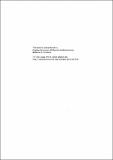| dc.contributor.author | Livingstone, Ian | |
| dc.date.accessioned | 2011-04-12T13:54:36Z | |
| dc.date.available | 2011-04-12T13:54:36Z | |
| dc.date.issued | 1977 | |
| dc.identifier.citation | Livingstone, Ian. (1977) Economic irrationality among pastoral peoples in East Africa: myth or reality?. Discussion Paper 245, Nairobi: Institute for Development Studies, University of Nairobi | en_GB |
| dc.identifier.uri | https://opendocs.ids.ac.uk/opendocs/handle/20.500.12413/664 | |
| dc.description.abstract | This paper represents an examination by an economist of the so-called
"theory of pastoral conservatism" in order to establish some limits as to its
validity and some ways in which this validity might be properly tested. To
most officials, overstocking arises out of the irrational 'cattle complex' of
the pastoralists, but this view is challenged by two alternative explanations
which are presented here: the economic 'common property' explanation that
overstocking is likely to arise from the divergence between private and social
interests so long as cattle are individually owned and the land is owned
communally, and the sociological explanation which refers to a number of
social functions of cattle beyond theprovision of sustenance. As an
alternative to these two explanations, it is suggested that an excess cattle
population may simply be associated with an excess human population. At any
rate, when assessing the proper stocking level in any area both the stock-to-land
ratio and the stock-to-human ratio must be taken into consideration.
A "lack of commercial-mindedness" among pastoralists is also frequently
hypothesised, but this notion must be tested with more systematic information
on marketing facilities , on the actual level of sales and on the stock-to-human
ratio. Evidence is presented that among the Pokot of northern Kenya
resistance to selling cattle in order to reduce the size of herds is very strong.
A case study from Tanzania also indicates that when a substantial investment
programme was carried out in a pastoral area, the number of livestock rose
enormousl. Some of this increase in numbers was ecologically supportable, but
a great deal was not.
Finally the usefulness of the term 'cattle complex' is questioned. The
focus should be rather on more testable propositions such as the holding of
excess stock, the level of sales, the willingness to limit large individual
holdings of cattle, the purchase (given an adequate level of realisable income)
of cash goods, and the like, which may throw light on behaviour and its
rationality according to some stated criteria. | en_GB |
| dc.language.iso | en | en_GB |
| dc.publisher | Institute for Development Studies, University of Nairobi | en_GB |
| dc.relation.ispartofseries | Discussion Papers;245 | |
| dc.rights.uri | http://creativecommons.org/licenses/by-nc-nd/3.0/ | en_GB |
| dc.subject | Economic Development | en_GB |
| dc.subject | Agriculture | en_GB |
| dc.title | Economic irrationality among pastoral peoples in East Africa: myth or reality? | en_GB |
| dc.type | Series paper (non-IDS) | en_GB |
| dc.rights.holder | Institute for Development Studies, University of Nairobi | en_GB |
| dc.identifier.blds | 322128 | |


